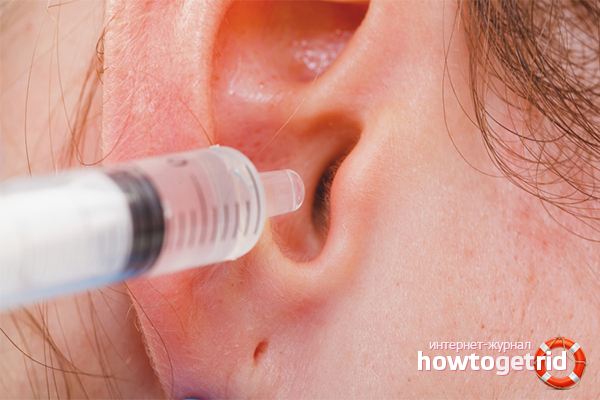The content of the article
Many of us do not even think about how to properly clean the ears, how often it should be done, and why improper ear hygiene can lead to hearing loss. Cleaning the ears takes an integral place in the life of every person. Many of us out of habit take a cotton swab, spit on it and violently twist it in the ear. This is fundamentally wrong.
From what we clean
The human auditory system consists of the outer shell, ear canal, middle and inner ear. We only clean the ear canal, the rest of the auditory element to a person, fortunately, is inaccessible. Ear pass covered with skin, which, in addition to sebum, produces a special secret - sulfur. Sulfur is not a useless substance that pollutes our ears. It protects the inner parts of the ear from infection, viruses, infections, protects the skin from drying out.
Along with sulfur, sebum, dust, and tiny specks accumulate in the ear canals. Normally, the human auditory system is self-cleaning. That is, when you actively move your jaw (chew or talk), all the pollution on its own slowly moving "to the exit." Therefore, the human body does not need an internal cleaning of the ears.
How to clean the ears
- Clean your ears after taking a shower or bath, when the skin is as steamed as possible and soft.
- Take a cotton swab and gently run it through the auricle. You can also clear the ear canal from the outside, that is, without penetrating deep inside.
- As noted, sulfur is derived on its own. However, it can accumulate in the ear canals if you have an increased secretion of this secret. Such a factor may be acquired (after injury) or congenital. Also, sulfur can clog the ear canals if they are too narrow or curved. In this case, you should regularly clean your ears, but not with a cotton swab, but with a cloth or cotton buds.
- Twist the braid out of the cotton and put it in the oil. After that, gently, with scrolling movements, clean the ear canal.
- It is impossible in any case to climb into the ears with foreign objects - pins, pencils, pins. Even the slightest damage can lead to inflammation and external otitis.
- According to experts, you need to clean the ears a couple of times a month, no more. Excessive sterility deprives the skin of natural protection. This can lead to itching and discomfort in the ears.
Why you can not clean the ears with cotton buds
The fact is that the design of a cotton swab does not contribute to the quality cleaning of the ear aisles. She pushes the sulfur inward, closer to the eardrum. Frequent and intensive manipulations with a cotton swab tamper with sulfur, which can lead to the formation of a sulfuric plug or a microtrauma to the ear canal, because the skin there is very tender and vulnerable.
Frequent brushing of the ears can upset the balance in earwax production. It becomes too much or too little. Lack of sulfur leads to discomfort and lack of natural protection. And an excess of sulfur inevitably leads to the formation of sulfur plugs.
Sulfur plug
Most people can live and not suspect that they have a sulfuric plug in their ears.The presence of this trouble is found after its swelling. If while bathing you get water in your ear, the sulfur plug will increase in size, putting pressure on the eardrum. This leads to unpleasant sensations - a person has dizziness, nausea, vomiting, tinnitus, and discomfort. Also about the presence of sulfuric cork (even if it is not swollen) says a feeling of resonance from his own voice. Sulfur cap is often formed in people who constantly wear headphones or hearing aids. In these cases, sulfur simply does not find a natural way out and is stuck in the ear canals.
Sulfuric cork must be washed out in time. If you have an increased production of sulfur and susceptibility to the formation of sulfuric plugs, the procedure should be carried out once every six months. It is best to do this with a specialist, otolaryngologist. However, with sufficient skill and knowledge of the principle of action, washing can be done independently at home.
How to wash ear from sulfuric cork
- Immediately wash the ear is not worth it, you need a little soak the cork to make it easier to get rid of. To do this, for three days, in the morning and in the evening, drip a drop of vegetable oil, petroleum jelly, glycerin or hydrogen peroxide into each ear.
- After three days you can start washing.To do this, take a syringe without a needle, water at room temperature, a small container and cotton pads.
- Type in the syringe water. In no case do not use cold, only warm. Sit on a chair and pull the ear a little up and to the side.
- Direct a stream of water from a syringe under pressure into the ear canal. If a doctor has ever done this to you, you will cope with the procedure yourself.
- Together with the water flowing from the ear, will come out and sulfur tube. After that, you should carefully wipe the ear with cotton discs. Put a cotton swab in your ear for an hour.
- After washing the ears can not go out at least for a while. If you still need to do this, you need to wear a hat.
How to get rid of itching in the ears
It so happens that a person, feeling the itching in the aisles, climbs there with sharp objects. This can not be done in any case. If you feel an itch, then the ear passages need natural lubrication. Just lubricate the delicate skin with vegetable oil and itching will pass. And in the future, try not so zealously and often to clean the ears.
According to statistics, the majority of otitis in children occurs due to frequent, thoughtless and thorough cleaning of the ears.If you do not have pathologies, the usual rubbing of the auricle with a towel after bathing is enough. Do not go too far and teach your children proper hygiene, so that it is the key to your health.
Video: how to clean the ears












To send
Useful article. I have long refused to cotton swabs, ENT said it was evil for the ears. Once a month I clean my ears with a nausea.